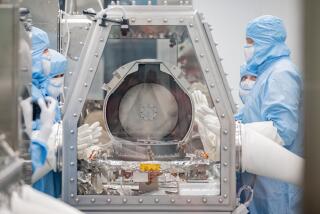Video chat: Welcome to Ceres! Dawn enters dwarf planet’s orbit

We talk with NASA about its most recent success: The Dawn spacecraft successfully entered into orbit around Ceres, fulfilling the first NASA mission to visit a dwarf planet, and the first to visit two distinct bodies in the solar system.
Scientists at the Jet Propulsion Laboratory are celebrating after NASA’s Dawn spacecraft entered orbit around Ceres early Friday morning, marking the first visit to a dwarf planet.
Launched in September 2007, Dawn traveled 3.1 billion miles over more than seven years to finally arrive at what officials called the largest unexplored world in the inner solar system.
The spacecraft entered orbit around 4:39 a.m. Friday, coming in at an altitude of around 38,000 miles. A confirmation signal came back about 5:36 a.m. Although the automated entry didn’t require a full control room at the Jet Propulsion Laboratory, the excitement caused mission team members to wax poetic.
“Ceres reached out and tenderly took Dawn into its permanent gravitational embrace,” Marc Rayman, Dawn’s chief engineer and mission director at JPL, said in a news briefing. It’s a journey that has been a long time coming, he added: “Ceres was discovered in 1801 and it’s beckoned for more than two centuries, and finally, today, Dawn answered that cosmic invitation.”
Ceres is a very special little world: It’s one of just five dwarf planets and it’s also the largest member of the asteroid belt, the rocky ring of debris between Mars and Jupiter. The asteroids are the building blocks of planets that never came to be, thwarted by Jupiter’s gravity. As such, they’re protoplanetary ‘fossils’ that scientists can study to understand more about the dawn of the solar system (an idea that inspired the mission’s name).
“It represents a remnant from the very beginning of our own solar system,” deputy principal investigator Carol Raymond said in a video chat with the Los Angeles Times. “By going there and investigating it, we’re going to learn more about how our planetary system formed. ”
Ceres was once thought to have a smooth, icy surface, but Dawn’s images of the dwarf planet have already altered scientists’ expectations. The surface is textured, with craters and basins -- and it features a pair of inexplicably dazzling bright spots that have captured the attention of both scientists and lay folk alike.
“Those bright spots are unique in the solar system,” Raymond said. As the spacecraft circles in closer and closer in a series of orbits over the coming months, she added, their true nature should become clear.
Don’t expect any new images for the next few weeks, though – Dawn is currently approaching from the dark side of the dwarf planet. Fresh views of this mini-world should come when Dawn’s first science orbit begins on April 23, when the spacecraft will be about 8,400 miles above the surface, Raymond said.
Ceres is Dawn’s second target; the spacecraft first visited another giant asteroid named Vesta, from 2011 to 2012. Ceres is round and wet, while Vesta is lumpy and dry. Although both bodies formed from roughly the same stuff, they ended up looking very different, rather like two siblings with different life histories.
Don’t ask Raymond to pick favorites, though.
“I like them both,” she said.
Can’t get enough of Ceres? Follow @aminawrite for more interplanetary science news.







